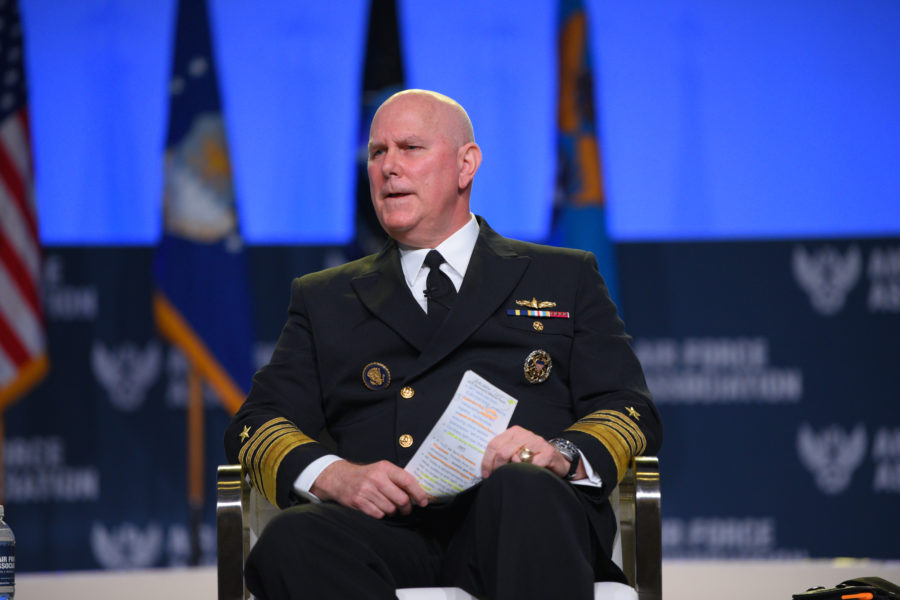The Joint Requirements Oversight Council, which decides which service equipment requests get funding priority, is changing its approach, making joint utility a top consideration rather than simply letting the services chase whatever technology they want, according to Adm. Christopher W. Grady, vice chairman of the Joint Chiefs of Staff and chair of the JROC.
Grady, speaking with the Atlantic Council’s Scowcroft Center said Dec. 4 that “we’re … making the JROC more effective” by “taking a top-down approach.”
The JROC is transitioning away from the traditional approach, in which the services bring a new requirement to the council and “we rubber stamp it and then they can go out and buy it,” Grady said, pegging this as a “bottom-up approach.”
“We’re doing a top-down approach which says, these are the requirements, and oh by the way, they devolved from … the Joint Warfighting Concept 3.0, which is now Joint Pub 1,” he said. Requirements are now “instantiated into the [joint] doctrine.”
“So now we write a good requirement and then any stakeholder can come forward and say, ‘OK, we can meet that.’ And so we try to close the gap, that requirement,” he added.
Stovepiped approaches have also been dropped in favor of “looking at [requirements] across portfolios of capability,” Grady said.
“That’s in line with the next thing that we tried to do to improve the efficiency of the JROC, and that is meld our process kind of simultaneously, as opposed to sequentially, with the acquisition side,” Grady said. “They have portfolios review … and so we’re bringing those together,” along with those under the undersecretary for research and engineering team, led by Heidi Shyu.
“So that forms a kind of a three-legged stool: of portfolios in requirement, portfolios in acquisition, and portfolios in technology and in R&D,” Grady said. “We’re trying to bring that all together.”
Such work builds on progress started by Grady’s predecessors, Air Force Gens. Paul Selva and John Hyten, he said.
Grady said he also wants to “put some teeth” into his position, to better enforce a joint approach to the requirements process.
“I can yell pretty loudly. But the services don’t have to do” as Grady directs. “I don’t have that authority to order them to do it.”
By comparison, Grady said his counterparts in countries like the United Kingdom, France, and Australia, do have that authority. Gaining it in the U.S. may require amending Title 10 authorities through legislation, but the vice chairman said he is “not certain that’s where we want to go.”
“At the very least, I can do a scorecard that says, ‘hey, all you JROC members … you signed up to do this. You said yes, we signed it out. Does that match with what we’re seeing in the budget?’ And if not, then we bring that forward to the Secretary and he makes the risk calculus. We can’t do that right now,” Grady said.
By “bringing some teeth” to the JROC process, “we can make it stronger,” he added.
As Grady seeks to empower the JROC, however, he warned that its effectiveness is threatened by the ongoing hold placed on most military promotions by Sen. Tommy Tuberville (R-Ala.). The hold has prevented most of the services’ vice chiefs—who all sit on the JROC—from being confirmed.
“One of the real values of the JROC is, you have the vices sitting there, [with] all that depth and breadth of experience,” Grady said. Without them, the council’s meetings have relied on specific subject matter experts.
“They’re really capable officers, but they come based on the specific issue,” Grady said. “That makes sense. That’s what I would do if I were in one of the one of the services, until they get their vice [confirmed]. But that depth and breadth, how it fits across the entire service portfolio, is probably not as strong as it would be if it was a vice sitting at the table.”
More broadly, among certain allies, there is also a new International JROC, Grady said. The group has had two meetings, set a governance process, and “we’re actually establishing requirements that we can work through together,” Grady said. “I can see that we will be able to take the output of the IJROC and be at least one requirements-driven input to AUKUS Pillar 2, which is the new technology space. That’s pretty exciting.”
